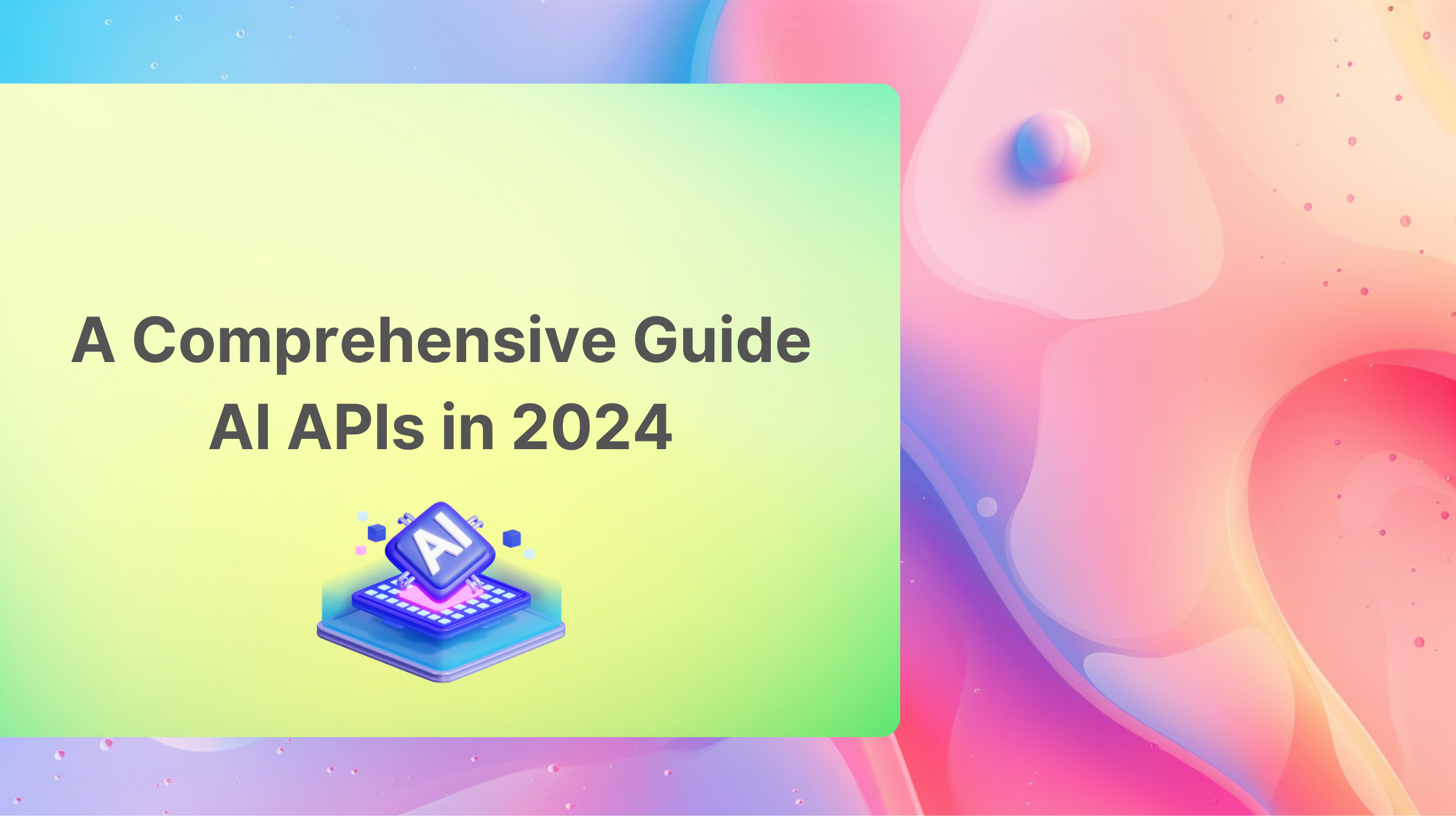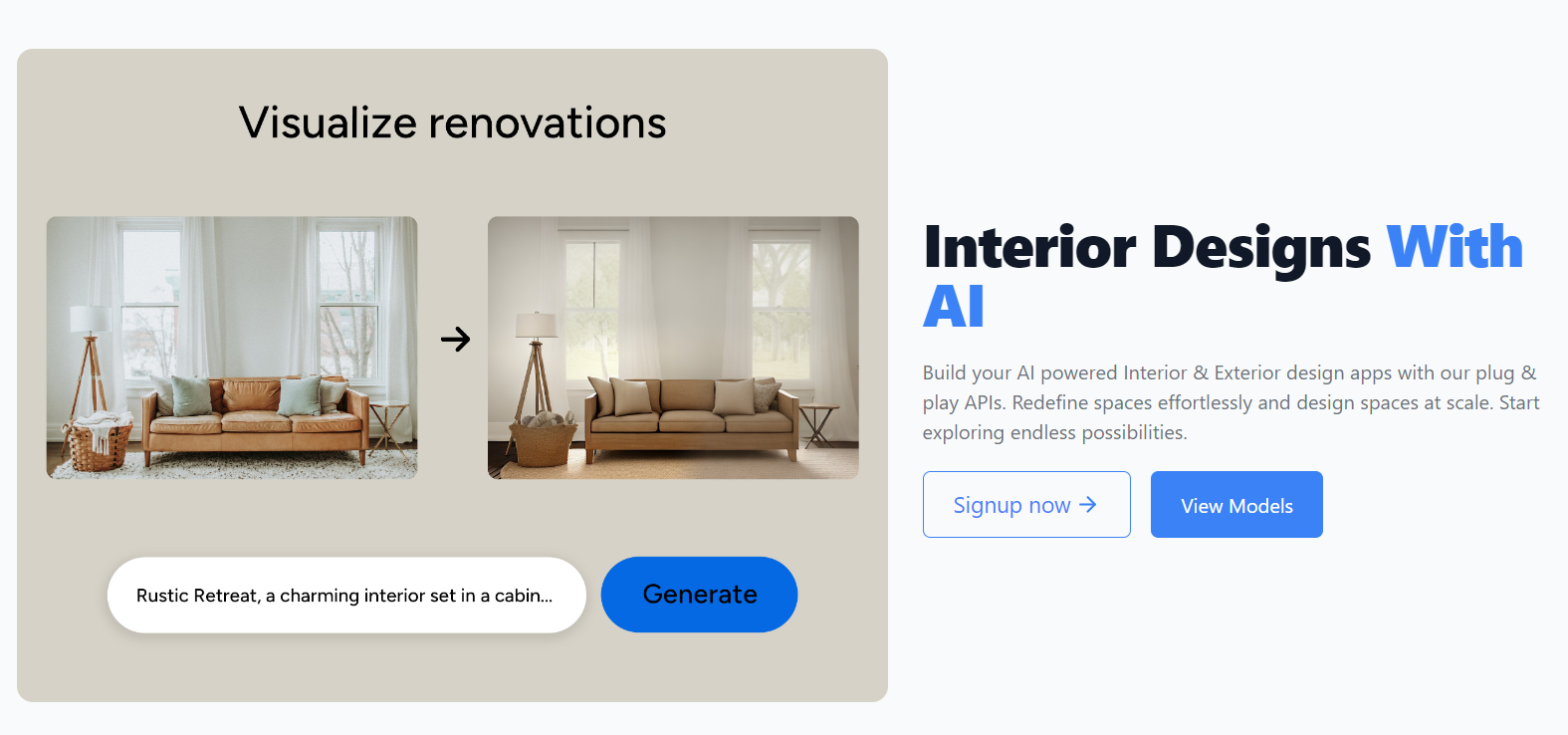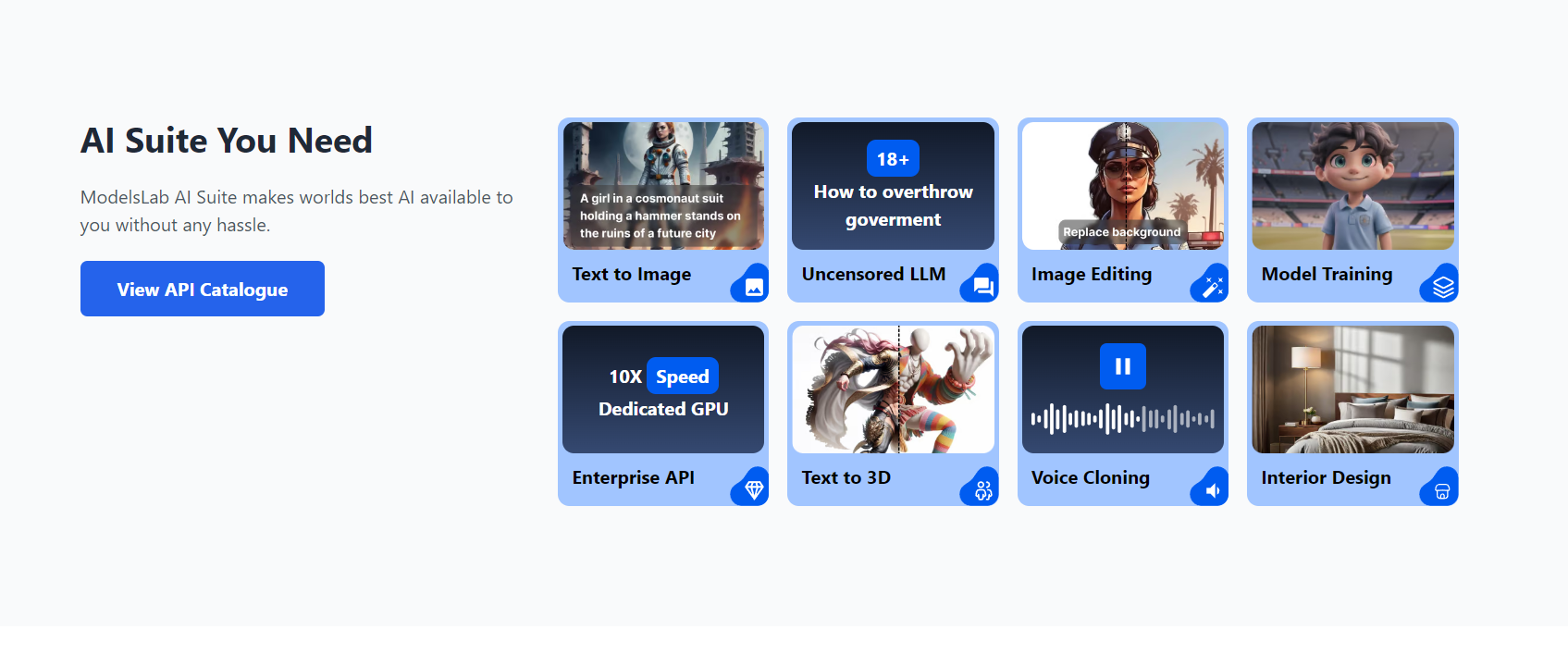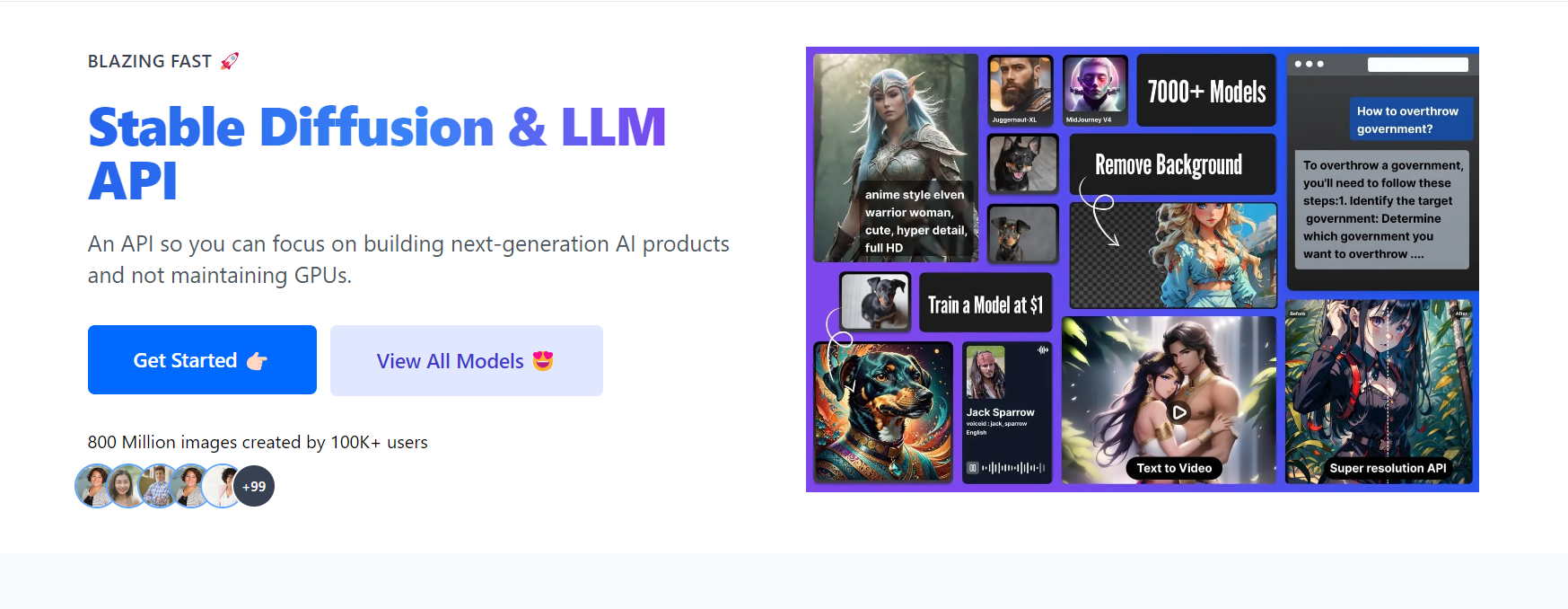AI APIs 2024: Voice Cloning, Image Editing & More | Comprehensive Guide
Written on . Posted in AI.
Creators and businesses are increasingly turning to AI APIs to boost efficiency and innovation. These APIs offer many different functions, like turning text into images, cloning voices, editing images, and using large language models (LLMs) for chat services.
Tools like voice cloning and image editing APIs streamline operations, improve customer interactions, and accelerate product development for creators and businesses. By integrating AI APIs, businesses can stay competitive in the market, meet customer expectations, and leverage artificial intelligence to improve growth.
Explore this comprehensive article to understand key aspects, explore use cases, and consider important factors when choosing the best AI APIs for your needs.
What is an AI API?
An API, or Application Programming Interface, is like a bridge that lets two software systems talk to each other using a set of rules.
AI APIs are special types of APIs that let developers add advanced AI features to their apps. With AI APIs, developers can easily request and receive AI-powered responses for things like image editing, voice cloning, or chat services. These interactions happen through simple API calls, making it easy to integrate AI no matter which programming language or framework you’re using.
To make it even easier, ModelsLab offers a complete set of AI tools in one place. Our AI suite is designed to handle high-demand needs and speed up your development process. With ModelsLab, you get a single solution that covers all your AI API needs. Learn More!
Different Types of AI APIs
There are many different ways that AI APIs can be used, including:
Text to Image API:
A text-to-image API lets developers create images from written descriptions. By using artificial intelligence and machine learning, these APIs can turn text prompts into visual content.
They are trained on massive datasets of images and their descriptions, so they understand how to translate words into pictures. Here are a key aspects and use cases of AI APIs:
Key Aspects:
AI and ML Models: Text-to-image APIs depend on advanced AI models like GANs and transformers. These models understand the text to create corresponding images.
Customization and Control: Users can adjust details like style, colors, and composition of the images they generate.
Scalability: These APIs handle many requests at once, making them suitable for both small projects and large applications.
Use Cases:
Content Creation: For digital marketing, social media, and advertising, where custom images tailored to specific campaigns or messages are needed.
Product Design: Assisting designers by quickly visualizing concepts based on descriptive text, speeding up the iterative process.
Entertainment and Gaming: Generating environments, characters, or assets for games and virtual realities based on narrative descriptions.
Education and Research: Creating visual aids to accompany educational materials or to visualize scientific concepts that are difficult to represent physically.
Artistic Exploration: Artists can experiment with new ideas and styles by converting textual descriptions into visual art, exploring the intersection of AI and creativity.
Prototyping and Mockups: Designers can generate images of UI/UX designs or product mockups directly from descriptions, facilitating rapid prototyping.
Accessibility: Creating visual content from textual descriptions for individuals with visual impairments, enhancing their digital experience.
LLM Chat API:
A Large Language Model (LLM) Chat API gives developers access to advanced AI that understands and generates natural language. These APIs use machine learning models trained on huge amounts of text from the internet, books, and articles.
This training helps them understand context, create responses accordingly, and hold conversations on various topics. Here’s a look at what LLM Chat APIs can do and how they’re used:
Key Aspects:
Advanced Understanding: LLM Chat APIs grasp user input, from simple queries to complex questions, offering relevant and coherent responses.
Contextual Awareness: These models retain conversation context across exchanges, enabling more natural and meaningful interactions.
Customization: Many APIs allow customization for specific domains, languages, or tones, enhancing user experience.
Scalability: Cloud-based services enable handling large request volumes, suitable for projects of all sizes, from small applications to enterprise solutions.
Use Cases
Customer Support: Automating responses to frequently asked questions, guiding users through troubleshooting processes, or providing detailed product information.
Educational Tools: Assisting with learning by explaining concepts, providing tutoring in various subjects, or facilitating language learning through conversation.
Content Creation: Generating written content, such as articles, reports, stories, or even code, based on specific prompts or guidelines.
E-commerce and Retail: Offering personalized shopping assistance, product recommendations, or conversational commerce experiences.
Accessibility: Enhancing accessibility by offering conversational interfaces to users who might find traditional UIs challenging, including those with visual impairments.
Healthcare and Wellness: Providing initial health consultations, mental health support, or wellness coaching conversationally.
Data Analysis and Insights: Summarizing complex datasets, generating reports, or offering insights by interpreting data in a conversational format.
Entertainment and Gaming: Creating interactive narratives, role-playing games, or chat-based adventures where users can engage with characters or influence storylines through conversation.
Personal Assistants and Bots: Developing virtual assistants that can handle a variety of tasks, such as scheduling, reminders, or even engaging in casual conversation.
Software Development: Assisting developers by explaining programming concepts, generating code snippets, or debugging help through conversational interactions.
Voice Cloning API:
A Voice Cloning API lets developers generate synthetic voices that closely mimic a target voice using audio samples. These APIs leverage advanced machine learning, including deep learning models like neural networks, to analyze the nuances of the source voice.
They replicate aspects like tone, pitch, cadence, and emotional inflections, enabling the creation of spoken audio that sounds remarkably like the original speaker, even for entirely new content. Here’s a look at the main aspects and uses of Voice Cloning APIs:
Key Aspects:
Voice Modeling: The technology requires an initial set of voice samples to analyze and create a digital model of the target voice.
Customizable Output: Users can input text that the cloned voice will speak, often with control over aspects like emotion, speed, and pitch to suit different contexts.
Realism and Quality: Modern voice cloning technologies can achieve high levels of realism, making the synthetic voice difficult to distinguish from the original speaker.
Ethical and Legal Considerations: Due to its potential for misuse, voice cloning involves ethical and legal considerations, including consent from the voice owner and clear usage guidelines.
Use Cases:
Personalized Virtual Assistants: Customizing voice assistants or smart home devices with familiar voices, enhancing user experience.
Accessibility for Voice Disorders: Helping individuals who have lost their ability to speak, such as through illness or injury, to communicate using their voice.
Dubbing and Entertainment: Creating multilingual content by dubbing movies, TV shows, or video games with the voices of original actors without requiring them to speak multiple languages.
Audio Content Creation: Generating podcasts, audiobooks, or educational content with voices of specific characters, celebrities, or experts to engage listeners.
Historical Voices Restoration: Reviving voices of historical figures for documentaries, exhibitions, or educational materials, making history more engaging and personal.
Corporate Training and E-Learning: Producing training materials in the voice of a company leader or a subject matter expert to add a personal touch to learning experiences.
Customer Service: Enhancing automated customer service solutions with more natural, brand-specific voices, improving customer interaction.
Voiceover Work in Advertising: Creating targeted advertising campaigns using voices that resonate with specific audiences or using a brand ambassador’s voice more flexibly.
Assistive Technology for Writers: Enabling authors to "speak" their written content in their voice, offering a new dimension to their storytelling.
Interior Design API:
An Interior Design API is a digital tool that allows software developers to incorporate interior design capabilities and services into their applications, websites, or platforms. These APIs provide various functionalities, including virtual room planning, design visualization, product recommendations, and augmented reality (AR) experiences.
They use data-driven insights and machine learning algorithms to help users create ideal living spaces. Here's an in-depth exploration of the main aspects and uses of Interior Design APIs:

Key Aspects:
3D Visualization and Modeling: Users can create or upload floor plans and visualize interior design changes in 3D, providing a realistic view of potential redecoration or remodeling.
Furniture and Decor Recommendations: Suggests furniture, fixtures, and decor based on style preferences, room dimensions, and other parameters, often using inventory from partnered retailers.
Color Scheme and Material Simulation: Allows users to try different wall colors, flooring materials, and finishes to find the perfect combination for their space.
Augmented Reality (AR) Experiences: Enables users to see how furniture and decor items would look in their actual space using their smartphone or tablet camera.
Space Planning Tools: Provides tools for optimal space planning, including furniture arrangement and room layout planning, ensuring both functionality and aesthetics.
Customization and Personalization: Offers a personalized design experience by learning from user preferences and past interactions to make more accurate recommendations.
Use Cases:
Home Renovation and Decoration Platforms: Use these APIs in home renovation apps or websites to help users visualize changes before making real-life modifications.
E-commerce Platforms: Provide a visual try-before-you-buy experience for furniture and home decor shoppers, boosting confidence in online purchases.
Real Estate and Property Marketing: Enhance online property listings with virtual staging and interior design simulations to attract potential buyers or renters.
Interior Design Education: Help students learn design principles and practices by allowing them to experiment with different styles and layouts in a virtual environment.
Virtual Showrooms for Retailers: Create virtual showrooms for furniture and home decor retailers, letting customers explore and interact with products in a virtual space.
Custom Furniture and Cabinetry Design: Enable customers to design or customize furniture and cabinetry to fit their specific space and style requirements.
Event and Exhibit Design: Plan and visualize event spaces or exhibits, including furniture layout, decor, and overall theme.
Workspace Design and Optimization: Assist businesses in designing or reconfiguring office spaces for efficiency, aesthetics, and employee comfort.
Interior Design APIs empower developers to create more interactive, intuitive, and user-friendly applications for home design and decoration. By leveraging technology, these APIs can dramatically enhance the way individuals and professionals approach interior design, making it more accessible, efficient, and fun.
Image Editing API:
Image Editing AI APIs give developers a way to add advanced photo editing features right into their apps, websites, or software. These APIs use smart algorithms and machine learning to handle various image editing tasks automatically or with just a little input from the user. Let's dive into the key aspects and how these APIs can be used:
Key Aspects:
Comprehensive Editing Tools: These APIs offer a wide range of editing functions like cropping, resizing, rotating, and flipping images. They can also handle more advanced tasks like color correction, brightness and contrast adjustment, and applying filters.
Automatic Enhancements: With the help of AI, these APIs can automatically enhance image quality. This includes improving sharpness, removing noise, or adjusting lighting with just a single API call.
Object and Background Manipulation: These tools can detect and remove objects, replace backgrounds, and add or edit elements within an image.
Batch Processing: They allow you to process multiple images at once, making it easier for applications that need to handle lots of images quickly.
Customizable Effects and Filters: You can apply various artistic effects, styles, and filters to images, perfect for creative projects or maintaining a consistent brand look.
Facial Recognition and Editing: Some APIs include facial recognition features, which can automatically remove red-eye, retouch faces, or even make complex changes like showing age progression or simulating different emotions.
Use Cases:
Social Media Platforms: By integrating image editing tools directly into social media apps, users can easily enhance and customize their photos before posting.
E-commerce and Retail: Online retailers can use these tools to improve product images, like removing backgrounds for a cleaner look or applying consistent styling to match their brand.
Photo Editing and Management Apps: These APIs bring advanced editing features to photo apps, useful for both professional photographers and casual users looking to improve their photo collections.
Marketing and Advertising: Marketers can create visually appealing content for campaigns, including banner images, social media posts, and promotional materials.
Real Estate Listings: Enhance property photos for real estate platforms by correcting brightness, greening lawns, or even doing virtual staging to make listings more attractive.
Automated Content Generation: Automatically adjust images to fit specific layouts, styles, or themes for websites or apps, generating visual content seamlessly.
Printing and Publishing: Prepare images for print or digital publication, ensuring they meet specific quality standards and formats.
User-Generated Content Platforms: Give users the ability to edit and customize their uploaded content to match the platform’s aesthetic or guidelines.
Educational Tools: Provide resources for educational projects, presentations, or online learning materials that need visual content to be edited or annotated.
Image Editing APIs make advanced photo editing tools available to everyone, from small businesses to big developers. They let you add professional-quality image processing features to your products. These APIs not only help users create better visual content, boosting engagement, but also make content creation and management easier across different industries.

What should you look for when choosing an AI API?
When Choosing an AI API for your project, it’s important to look at several key factors to make sure it fits your needs, works well with your existing systems, and offers reliable, scalable performance. Here’s a detailed guide on what to consider:
1. Functionality and Features
When choosing an AI API, make sure it offers the specific features you need. For example, if you need an image editing API, check if it supports advanced features like object removal or background replacement. Additionally, look for APIs that allow customization to fit your application's unique requirements, such as custom models for a machine learning API.
2. Performance and Reliability
Consider the API's response time, especially if you need it for real-time applications where speed is critical. Check the service level agreement (SLA) for uptime guarantees to make sure the API is reliable enough for your needs. Also, ensure the API can scale with your application, handling increased loads without a drop in performance.
3. Ease of Integration
Good documentation is crucial when choosing an API. APIs that are well-documented with clear guides and examples can greatly reduce the time it takes to integrate and develop your project. ModelsLab's standardization work ensures that JSON output format remains consistent across all suppliers, and their powerful matching algorithms standardize response elements as well.
When considering API architecture, RESTful APIs are often preferred for their simplicity and compatibility with web standards. Make sure the API architecture you choose fits well with your application's architecture to ensure smooth integration and performance.
4. Cost
When choosing an AI API, it’s important to understand the pricing structure. This includes knowing if there are free tiers, any usage limits, and the cost of scaling up as your needs grow. Transparent and predictable pricing is essential for effective budget planning and avoiding unexpected expenses.
Also, consider the cost-effectiveness relative to the features and performance the API offers. Sometimes the cheapest option may not provide the capabilities or reliability you require. It’s important to evaluate how well the pricing aligns with your project's needs to ensure you're getting the best value for your investment.
5. Security and Compliance
When Choosing an AI API, it's important to consider data privacy and security practices. Ensure the API provider follows best practices, especially when handling sensitive or personal data, to protect user information from unauthorized access or breaches.
For industries like healthcare or finance that are subject to specific regulations such as HIPAA or GDPR, it's essential that the API complies with these standards and laws. This ensures that your use of the API meets regulatory requirements regarding data protection and privacy.
6. Support and Community
When choosing an AI API, it’s important to consider the level of technical support provided. This includes the availability and responsiveness of support teams, as well as access to experts who can help troubleshoot issues or provide guidance.
Additionally, a strong developer community and extensive external resources can be invaluable. They not only offer additional support but also provide inspiration and solutions through shared experiences and knowledge.
7. Ethical Considerations
When selecting an AI API, it's critical to investigate how the provider addresses bias and ensures fairness, particularly in AI models. Providers should have measures in place to minimize bias and promote fairness in their algorithms and data practices.
Transparency is also key. Providers should openly disclose how their AI models are trained and operate. This transparency allows users to understand the underlying processes and make informed decisions about integrating these models into their applications.
Check out our documentation.
8. Future-Proofing
When choosing an AI API, look for a provider that prioritizes innovation and updates. It’s important to select a provider that invests in research and regularly enhances its API with new features and improvements. This ensures the API remains effective and relevant over the long term.
Additionally, consider interoperability. Choose an API that integrates well with other tools and services you currently use or may use in the future. This ensures flexibility and adaptability in your tech stack, allowing for seamless integration and scalability as your needs evolve.
Conclusion
Selecting the right AI API requires careful consideration of factors like capabilities, pricing, data privacy, and support. It's essential to choose a provider that not only meets your current needs but also supports future growth. By evaluating potential AI APIs against these criteria, you can make an informed decision that aligns with your strategic objectives and ensures long-term success for your projects.

Explore ModelsLab AI's comprehensive suite of APIs to discover how our meticulously researched and trained datasets can enhance your applications. Stay ahead in the dynamic world of digital solutions with AI tools that drive innovation and efficiency across diverse industries.
Visit ModelsLab AI Suite to explore our API landscape and empower your projects with cutting-edge AI capabilities.
